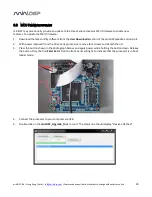
miniDSP Ltd – Hong Kong / Email :
/ Features and specifications subject to change without prior notice
27
4.2.3
Guidelines for target curve design
Care should be taken to create a target curve that works well with your speakers and room, as well as suiting
your personal preferences. Small changes to the target curve can have significant effects on the tonal quality of
the system, so it is important that you experiment with different target curves to find the optimum.
If you initially don’t achieve a satisfactory result, please ensure that you have spread your measurements over a
sufficiently large area and with sufficient variation in height. The following guidelines will help you understand
how to adjust your target curve.
Low-frequency extension and boost
All loudspeakers have a natural low-frequency roll off. Setting the target curve to boost the
region below the speaker’s natural roll off frequency
may
result in overdriving the speakers,
especially with smaller home loudspeakers and depending on your listening habits. A system
with capable subwoofers integrated into it, however, will support much more low-frequency
output.
The auto-target estimates the low-frequency roll-off and curve, and in some cases may include
some amount of boost if it estimates that the speakers are capable of handing it. You should
determine by
listening
whether this estimate is suitable for your speakers, and adjust the target
curve accordingly.
High-frequency “tilt”
The target curve is the desired measured response of loudspeakers
in a room,
In contrast to
measurements made of a loudspeaker during its design under anechoic (measured in free space)
conditions. While high-quality loudspeakers are usually designed for a flat on-axis anechoic
response, these same speakers when placed into a listening room will tend to have a downward-
sloping or “tilting” response at high frequencies, due to the effects of limited dispersion at high
frequencies and greater acoustic absorption.
A completely flat in-room response is therefore usually not desirable and will tend to sound thin
or bright. Start with a target curve that follows the natural behavior of your speakers in your
room, and then experiment with greater or lesser degrees of tilt in the treble region to obtain
the most natural timbral balance.
Low-frequency adjustment
A completely flat response at low frequencies, with complete elimination of peaks due to room
modes, may sound light in the bass. Often, a slight increase in the target curve below 100 Hz will
give a more balanced sound, yet without introducing audible irregularities in bass response.
Magnitude response dips
In some cases, it may be helpful to adjust the target curve to follow dips in the magnitude
response. This can occur where, for example, the listening area is very close to the speakers and
the measurements exhibit a dip caused by the vertical response of the speakers themselves. In
such a case, adjusting the magnitude response to follow the dip will avoid making the speakers
sound worse elsewhere in the room. (You may also wish to try a different set of measurement
locations.)










































